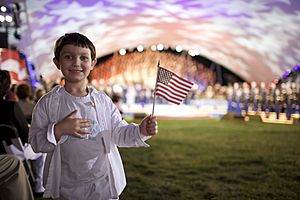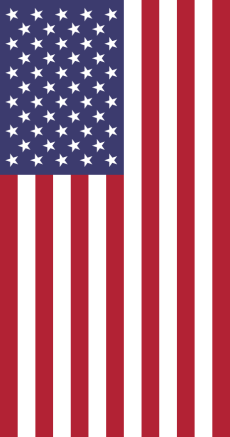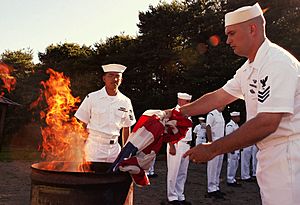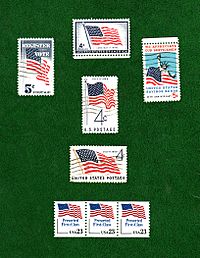Flag of the United States facts for kids
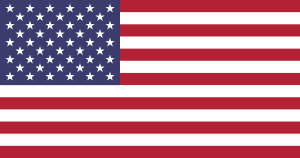 |
|
| Names | The American flag,
|
|---|---|
| Use | National flag and ensign |
| Proportion | 10:19 |
| Adopted |
|
| Design | Thirteen horizontal stripes alternating red and white; in the canton, 50 white stars of alternating numbers of six and five per horizontal row on a blue field |
| Designed by | Robert G. Heft (50-star version) |
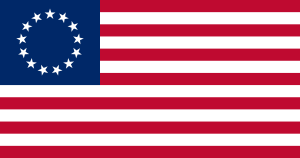
The flag of the United States of America is a national flag. It represents the freedom of the United States.
The flag of the United States has seven red stripes and six white stripes. These 13 stripes stand for the original thirteen colonies. The flag also has a blue canton, a rectangle in the top left corner. The canton has one white star for every state.
When a new state joins the United States, a new flag is made with an extra star. The new flag is first flown on Independence Day, which is celebrated on and also called the "Fourth of July."
The last states to join the United States were Alaska and Hawaii in 1959. Alaska joined on January 3, 1959, so the new flag with 49 stars was first flown on July 4, 1959. Because Hawaii joined on August 21, 1959, the flag with 50 stars was not flown until July 4, 1960.
The colors in the flag are red, white, and blue. Red stands for bravery and strength; white stands for purity and innocence; and blue stands for watchfulness, perseverance, and justice.
The flag is also often called the Stars and Stripes, the Star-Spangled Banner, or Old Glory. The national anthem of the United States calls the flag the "Star-Spangled Banner."
Contents
Design
- 13 horizontal (meaning from side to side, not top to bottom) red and white stripes, representing the original 13 states.
- 50 white stars on a blue rectangle in the top-left (the canton), representing the current 50 U.S. states.
Display and use
The flag is normally flown year-round at most public buildings, and many private homes fly full-size (3 by 5 feet (0.91 by 1.52 m)) flags. Some citizens fly a flag in front of their homes year-round, but more people fly flags on civic holidays like Memorial Day, Veterans Day, Presidents' Day, Flag Day, and Independence Day. On Memorial Day, it is common to place small flags by war memorials and next to the graves of U.S. war veterans. It is customary to fly the flag at half-staff until noon in remembrance of those who lost their lives fighting in U.S. wars.
Flag etiquette
The United States Flag Code describes certain guidelines for the use, display, and disposal of the flag. For example, the flag should never be dipped (lowered and then raised again) to any person or thing.
The flag should never be allowed to touch the ground and, if flown at night, must be illuminated. If the edges become tattered through wear, the flag should be repaired or replaced. When a flag is so tattered that it can no longer serve as a symbol of the United States, it should be destroyed in a dignified manner, preferably by burning.
The Flag Code does not allow anyone to use the flag "for any advertising purpose" or to put it on clothing or other items that can be thrown away. Both of these codes are generally ignored.
An additional part of Section 8, Respect For Flag, that is frequently violated at sporting events is part (c): "The flag should never be carried flat or horizontally, but always aloft and free."
Although the Flag Code is U.S. federal law, there is no penalty for a private citizen or group failing to obey the Flag Code. Enforcement would go against the First Amendment right to freedom of speech.
Display on vehicles
When the flag is attached to a vehicle of any kind (e.g.: cars, boats, planes, or any physical object that moves), it should be positioned so that the canton is toward the front of the vehicle, as if the flag were streaming backward from its pole as the vehicle moves forward.
The flag has been displayed on every U.S. spacecraft designed for manned flight, including Mercury, Gemini, Apollo Command/Service Module, Apollo Lunar Module, and the Space Shuttle. The flag also appeared on the S-IC first stage of the Saturn V launch vehicle used for Apollo. The streaming rule could not be followed on space flights, however, because the ships launch and land vertically.
Display on uniforms
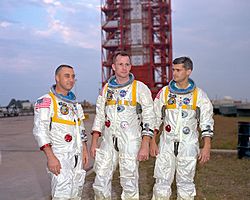

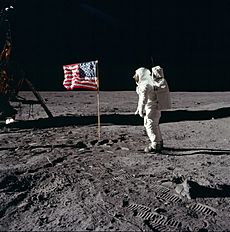
On some U.S. military uniforms, flag patches are worn on the right shoulder with the canton toward the front. This rule dates back to the Army's early history when both mounted cavalry and infantry units would assign a standard-bearer who carried the Colors into battle. As he charged, his forward motion caused the flag to stream back. Since the Stars and Stripes are mounted with the canton closest to the pole, that section stayed to the right, while the stripes flew to the left. Several U.S. military uniforms, such as flight suits worn by members of the United States Air Force and Navy, have the flag patch on the left shoulder.
Other organizations that wear flag patches on their uniforms can have the flag facing in either direction. The congressional charter of the Boy Scouts of America says that the uniforms should not imitate U.S. military uniforms; therefore, the flags are displayed on the right shoulder with the stripes facing front, the reverse of the military style. Law enforcement officers often wear a small flag patch, either on a shoulder or above a shirt pocket.
Every U.S. astronaut since the crew of Gemini 4 has worn the flag on the left shoulder of his or her space suit, except of the crew of Apollo 1, whose flags were worn on the right shoulder. In this case, the canton was on the left.
Postage stamps
The flag did not appear on U.S. postal stamp issues until the Battle of White Plains Issue was released in 1926, showing the flag with a circle of 13 stars. The 48-star flag first appeared on the General Casimir Pulaski issue of 1931 in a small monochrome depiction. The first U.S. postage stamp to feature the flag as the only subject was issued July 4, 1957, Scott catalog number 1094. Since that time, the flag has frequently appeared on U.S. stamps.
Display in museums
In 1907, Eben Appleton, a New York stockbroker and grandson of Lieutenant Colonel George Armistead (the commander of Fort McHenry during the 1814 bombardment) loaned the Star-Spangled Banner Flag to the Smithsonian Institution, and in 1912, he changed the loan to a gift. Appleton donated the flag with the wish that it would always be able to be viewed by the public. In 1994, the National Museum of American History determined that the Star-Spangled Banner Flag required further conservation treatment to remain on public display. In 1998, teams of museum curators and other specialists helped move the flag from its home in the Museum's Flag Hall into a new conservation section of the museum. Since the reopening of the National Museum of American History on November 21, 2008, the flag has been on display in a special exhibition called "The Star-Spangled Banner: The Flag That Inspired the National Anthem," where it rests at a 10-degree angle in dim light to help it last longer.
Places of continuous display
By presidential proclamation, acts of Congress, and custom, U.S. flags are always displayed at certain locations.
- Marine Corps War Memorial (Raising the Flag on Iwo Jima), Arlington, Virginia
- The Battle Green in Lexington, Massachusetts, site of the first shots fired in the Revolution
- The White House, Washington, D.C.
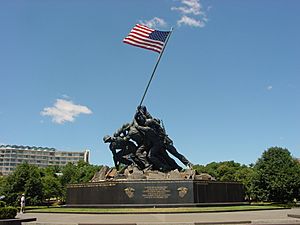
- At U.S. Customs and Border Protection Ports of Entry that are continuously open
- Grounds of the National Memorial Arch in Valley Forge NHP, Valley Forge, Pennsylvania
- By custom, at the Maryland home, birthplace, and grave of Francis Scott Key; at the Worcester, Massachusetts war memorial; at the plaza in Taos, New Mexico (since 1861); at the United States Capitol (since 1918); and at Mount Moriah Cemetery in Deadwood, South Dakota
- Newark Liberty International Airport's Terminal A, Gate 17 and Boston Logan Airport's Terminal B, Gate 32 and Terminal C, Gate 19 in memoriam of the events of September 11, 2001
- Slover Mountain (Colton Liberty Flag), in Colton, California; July 4, 1917, to circa 1952 and 1997 to 2012
- At the ceremonial South Pole as one of the 12 flags representing the signatory countries of the original Antarctic Treaty
- Replicas of the Star-Spangled Banner Flag (15 stars, 15 stripes) are flown at two sites in Baltimore, Maryland: Fort McHenry National Monument and Historic Shrine and Flag House Square.
- A Civil War-era flag (for the year 1863) flies above Pennsylvania Hall (Old Dorm) at Gettysburg College. This building, occupied by both sides at various points of the Battle of Gettysburg, served as a lookout and battlefield hospital.
- Fifty U.S. flags are displayed continuously at the Washington Monument, Washington, D.C.
- On the Moon: six manned missions successfully landed at various locations and each had a flag raised at the site. Exhaust gases when the Ascent Stage launched to return the astronauts to their Command Module Columbia for return to Earth blew over the flag the Apollo 11 mission had placed.
Particular days for display
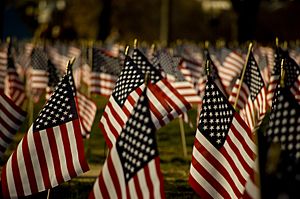
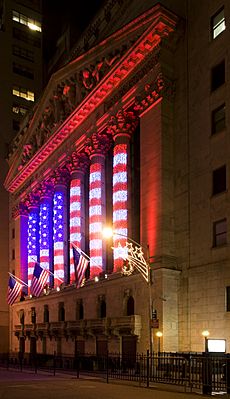
The flag should especially be displayed at full staff on the following days:
- January: 1 (New Year's Day), third Monday of the month (Martin Luther King Jr. Day), and 20 (Inauguration Day, once every four years, which, by tradition, is postponed to the 21st if the 20th falls on a Sunday)
- February: 12 (Lincoln's birthday) and the third Monday (legally known as Washington's Birthday but more often called Presidents' Day)
- March–April: Easter Sunday (date varies)
- May: Second Sunday (Mother's Day), third Saturday (Armed Forces Day, which honors those currently serving in the U.S. military), and last Monday (Memorial Day; half-staff until noon)
- June: 14 (Flag Day), third Sunday (Fathers Day)
- July: 4 (Independence Day) and 27 (National Korean War Veterans Armistice Day)
- September: First Monday (Labor Day), 11, (Patriot Day), 17 (Constitution Day), and last Sunday (Gold Star Mother's Day)
- October: Second Monday (Columbus Day) and 27 (Navy Day)
- November: 11 (Veterans Day) and fourth Thursday (Thanksgiving Day)
- December: 25 (Christmas Day)
- and such other days as may be proclaimed by the President of the United States; the birthdays of states (date of admission); and on state holidays.
History
The flag has been changed 26 times since the new, 13-state union adopted it. The 48-star version went unchanged for 47 years until the 50-star version became official on July 4, 1960 (the first July 4 following Hawaii's admission to the union on August 21, 1959). The 47-year-record of the 48-star version was the longest time the flag went unchanged until July 4, 2007, when the current 50-star version of the Flag of the United States broke the record.
First flag
At the time of the signing of the Declaration of Independence, July 4, 1776, the United States had no official national flag. The Grand Union Flag has historically been known as the "First National Flag." Although it has never had any official status, it was used throughout the American Revolutionary War by George Washington and formed the basis for the design of the first official U.S. flag.
The origins of the design are unclear. One theory is that it may be based on the British East India Company (BEIC) flag of the same era. Another theory says that it could be based on the Washington family coat-of-arms. The flag was more likely based on a flag of the Sons of Liberty, whose flag consisted of 13 red-and-white alternating horizontal stripes.
Claims of credit
Francis Hopkinson of New Jersey, a naval flag designer and a signer of the Declaration of Independence, claimed that he had designed a flag in 1777 while he was the chairman of the Continental Navy Board's Middle Department. He claimed that he designed the flag for the U.S. Navy. The Journals of the Continental Congress document the letter and bills he sent to Congress for his work.

Hopkinson's story contradicts the legend of the Betsy Ross flag, which suggests that she sewed the first Stars and Stripes flag at the request of the government in the Spring of 1776. This story has been passed down by descendants of Betsy, who did run an upholstery business. Ross's grandson, however, admitted that his own search through the Journals of Congress and other official records failed to find supporting evidence for his grandmother's story.
The family of Rebecca Young claimed that she sewed the first flag. Young's daughter was Mary Pickersgill, who made the Star-Spangled Banner Flag. She was assisted by Grace Wisher, a 13-year-old African American girl.
The Flag Resolution of 1777
On June 14, 1777, the Marine Committee of the Second Continental Congress passed the Flag Resolution which stated: "Resolved, that the flag of the United States be thirteen stripes, alternate red and white; that the union be thirteen stars, white in a blue field, representing a new Constellation." Flag Day is now observed on June 14 of each year.
Later Flag Acts
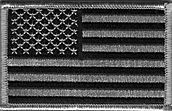
In 1795, the number of stars and stripes was increased from 13 to 15 (to reflect the entry of Vermont and Kentucky as states of the Union). For a time, the flag was not changed when more states were admitted, probably because it was thought that this would cause too much clutter. It was the 15-star, 15-stripe flag that inspired Francis Scott Key to write "The Star-Spangled Banner," now the national anthem.
On April 4, 1818, a plan was passed by Congress at the suggestion of U.S. Naval Captain Samuel C. Reid in which the flag was changed to have 20 stars, with a new star to be added when each new state was admitted. The number of stripes would remain at 13 to honor the original colonies. The act stated that new flag designs should become official on the first July 4 (Independence Day) after the addition of one or more new states. The most recent change, from 49 stars to 50, occurred in 1960 when the present design was chosen, after Hawaii gained statehood in August 1959. Before that, the admission of Alaska in January 1959 prompted the introduction of a short-lived 49-star flag.
As of July 4, 2007, the 50-star flag has become the longest rendition in use.
Historical progression of designs
In the following table showing the 28 various designs of the United States flag, the star patterns for the flags are merely the usual patterns, often associated with the United States Navy. Canton designs, before the announcement of the 48-star flag by President William Howard Taft on October 29, 1912, had no official arrangement of the stars. The exact colors of the flag were not standardized until 1934.
| No. of Stars |
No. of Stripes |
Design | States Represented by New Stars |
Dates in Use | Duration |
|---|---|---|---|---|---|
| 0 | 13 |  |
N/A | December 3, 1775–June 14, 1777 | 1 year (18 months) |
| 13 | 13 |  |
Delaware, Pennsylvania, New Jersey, Georgia, Connecticut, Massachusetts, Maryland, South Carolina, New Hampshire, Virginia, New York, North Carolina, Rhode Island |
June 14, 1777–May 1, 1795 | 18 years (215 months) |
| 15 | 15 |  |
Kentucky, Vermont | May 1, 1795–July 3, 1818 | 23 years (278 months) |
| 20 | 13 |  |
Indiana, Louisiana, Mississippi, Ohio, Tennessee |
July 4, 1818–July 3, 1819 | 1 year (12 months) |
| 21 | 13 |  |
Illinois | July 4, 1819–July 3, 1820 | 1 year (12 months) |
| 23 | 13 |  |
Alabama, Maine | July 4, 1820–July 3, 1822 | 2 years (24 months) |
| 24 | 13 |  |
Missouri | July 4, 1822–July 3, 1836 | 14 years (168 months) |
| 25 | 13 |  |
Arkansas | July 4, 1836–July 3, 1837 | 1 year (12 months) |
| 26 | 13 |  |
Michigan | July 4, 1837–July 3, 1845 | 8 years (96 months) |
| 27 | 13 |  |
Florida | July 4, 1845–July 3, 1846 | 1 year (12 months) |
| 28 | 13 |  |
Texas | July 4, 1846–July 3, 1847 | 1 year (12 months) |
| 29 | 13 |  |
Iowa | July 4, 1847–July 3, 1848 | 1 year (12 months) |
| 30 | 13 |  |
Wisconsin | July 4, 1848–July 3, 1851 | 3 years (36 months) |
| 31 | 13 |  |
California | July 4, 1851–July 3, 1858 | 7 years (84 months) |
| 32 | 13 |  |
Minnesota | July 4, 1858–July 3, 1859 | 1 year (12 months) |
| 33 | 13 |  |
Oregon | July 4, 1859–July 3, 1861 | 2 years (24 months) |
| 34 | 13 |  |
Kansas | July 4, 1861–July 3, 1863 | 2 years (24 months) |
| 35 | 13 |  |
West Virginia | July 4, 1863–July 3, 1865 | 2 years (24 months) |
| 36 | 13 |  |
Nevada | July 4, 1865–July 3, 1867 | 2 years (24 months) |
| 37 | 13 |  |
Nebraska | July 4, 1867–July 3, 1877 | 10 years (120 months) |
| 38 | 13 |  |
Colorado | July 4, 1877–July 3, 1890 | 13 years (156 months) |
| 43 | 13 |  |
Idaho, Montana, North Dakota, South Dakota, Washington |
July 4, 1890–July 3, 1891 | 1 year (12 months) |
| 44 | 13 |  |
Wyoming | July 4, 1891–July 3, 1896 | 5 years (60 months) |
| 45 | 13 |  |
Utah | July 4, 1896–July 3, 1908 | 12 years (144 months) |
| 46 | 13 |  |
Oklahoma | July 4, 1908–July 3, 1912 | 4 years (48 months) |
| 48 | 13 |  |
Arizona, New Mexico | July 4, 1912–July 3, 1959 | 47 years (564 months) |
| 49 | 13 |  |
Alaska | July 4, 1959–July 3, 1960 | 1 year (12 months) |
| 50 | 13 |  |
Hawaii | July 4, 1960–present | 63 years (765 months) |
Interesting facts about the flag of the United States
- The flag has been changed twenty-seven times: each time a new state was added to the United States.
- The current flag was designed by a seventeen-year-old high school student, Robert G. Heft. President Dwight D. Eisenhower chose the Ohio student’s design from 1,500 entries.
- A vexillologist is a person who studies flags.
- The flag is only to be displayed from sunrise to sunset unless it is "properly Illuminated" in the dark.
- The flag should be flown during school days in or near the school building.
- The proper way to view a flag when it is on display is by facing the flag with your right hand over your heart.
- The proper way to raise the flag is quickly; the proper way to lower the flag is slowly.
- The military folds the flag with thirteen folds. Each fold has a symbolic meaning.
- When the flag is flown upside down, it is a signal of distress.
- After a national tragedy, the flag is flown at half-staff for thirty days.
- If there is more than one flag flying on a flagpole, the United States flag should always be above the others.
- Francis Scott Key, the author of the U.S. national anthem "The Star-Spangled Banner," witnessed the British rockets and bombs bursting around the flag during the British attack at Fort McHenry. The flag did not fall in the attack.
Images for kids
-
Our Banner in the Sky (1861) by Frederic Edwin Church
-
An American flag now flies over Gate 17 of Terminal A at Newark Liberty International Airport in Newark, New Jersey, departure gate of United Airlines Flight 93 on 9/11.
-
An American flag on the U.S. embassy in Warsaw during a German air raid in September 1939
-
The NASA Vehicle Assembly Building in 1977. The VAB has the largest U.S. flag ever used on a building, with the Bicentennial Star opposite the flag.
-
Gravestones at Arlington National Cemetery decorated with U.S. flags on Memorial Day.
See also
 In Spanish: Bandera de los Estados Unidos para niños
In Spanish: Bandera de los Estados Unidos para niños


